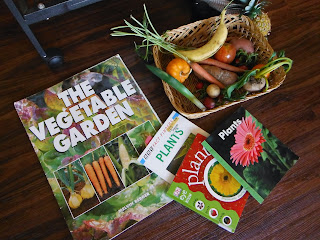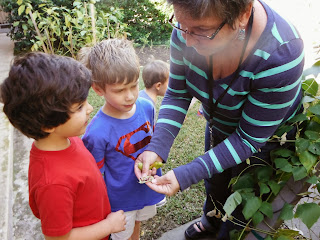Continuing our exploration of plants,
we began a conversation about structure and function. I opened the conversation with the question, " What parts make up your body?" Not surprisingly, the answers came easily, such as, legs, hands, brain, tummy, bones, and knees.
I then asked, "what job do those parts do for your body?" This question took a little more thinking, but eventually the answers were offered. The students said legs were for walking, teeth help you eat, ears help you hear, and bones help "carry your brain". We all agreed that every part of their body had a specific job that helped the whole body function properly.
Next, I showed them the plant recently pulled from our garden. I had it mounted onto a presentation board so that everyone could see it. I asked them to name the parts of the plant. Each student that volunteered the answer had the opportunity to write the name next to the part. This activity incorporated literacy skills in a relevant manner. I asked each student if they preferred that I write the word on a piece of paper so that they could see the letters first, or if they wanted me to spell the word out loud as they wrote each letter.
Then the students watched a video that described the function of the root, stem, leaves, and flower. The students learned that roots act like a straw as they drink up water from the soil. The stem carries the water throughout the plant, and supports the plant.



The leaves make food for the plant, utilizing energy from the sun. We decided the leaves were the "kitchen" where the food is prepared. And finally, the flower is where new seeds are formed so new plants can grow. One student described the stem as "a long neck". Another student said the roots "make it (plant) still and it sucks the water". The Pre K students completed their investigation by documenting their understanding.

 The Three Year Old classes explored living plants, and had to locate and name each part of the plant. They used hand lenses to look at the tiny roots.
The Three Year Old classes explored living plants, and had to locate and name each part of the plant. They used hand lenses to look at the tiny roots.The last week of the plant discovery, the students had the opportunity to apply their learning. Several stations were available for the students to revisit the various concepts learned over the previous weeks.
The light table had an assortment of plant parts to investigate. Another table displayed a variety of plant seeds. A research center provided books and authentic samples to compare and contrast.
Finally, the students went out to the garden to locate parts of the plants and discuss their functions. Several days after this exploration ended, a 4 year old boy was showing his family the garden. A pod was picked from the hyacinth bean vine. His mother said, "oh that is a bean". The student said, "no it is a seed".
Over the course of several weeks, this concept allowed for differentiated learning experiences. The students received information from live samples, science videos, a digital microscope,books, and verbal discussion. As a facilitator, I was able to assess understanding in multiple ways. Students could respond verbally to questions, they could visually document their understanding with a drawing, or they could locate real examples from their environment. Literacy, science, wonder, discovery, and understanding all came together in a conversation about plants.







No comments:
Post a Comment